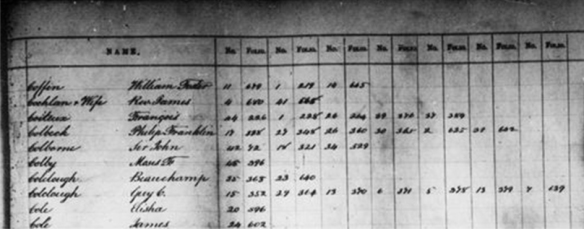By Rebecca Murray
Reference Services frequently receives requests about land patents in Canada. Here, we will focus on pre-Confederation land documents. Be sure to refer also to Crown land patents: Indian land sales for more information. The next post on land patents will focus on post-Confederation land patents.
What is a Land Patent?
Land patents are issued by the Crown to grant or confirm title to a portion of land. They represent the first title to land, and serve as proof that the land no longer belongs to the Crown.
How Do I Find a Land Patent?
As this is a challenging request even for practiced archivists, this post will guide you through an example of how to approach this type of research from home or while onsite at Library and Archives Canada (LAC).
Step 1:
Start with the information you have: a date, a location, a person or organization (patentee). It is preferable to proceed with all three pieces of information (especially the date), but you can find the answer with one or more of the pieces of information.
Example:
- Date (specific or general): June 7, 1856
- Location (detailed or general): Lot 8, Range 3, east of Plank Road, Township of Seneca
- Patentee: David Patterson
Step 2:
With the patentee and date, or the date and location, you can look at the Indexes to Indian and Ordnance Land Patents (nominal [by name] and geographical indices) for the period 1845–1867 found in RG68, volume 911, microfilm reel M-1638. With the patentee and location, you can consult either the nominal or the geographical indices but without the date, you will have to perform a wider search using the General Index.
In this case, I found an entry for David Patterson in the Indexes to Indian and Ordnance Land Patents (RG68 volume 911, microfilm reel M-1638) and noted that the corresponding entry would be found in Liber EO (some libers are titled by letters rather than numbers), on folio 172.
Step 3:
Once you know the liber (register) and folio (page number), you need to find that liber within RG68 records. There are two options for continuing your search:
Web-Based Search
- Begin in Collection Search with the search string: RG68 68-2 land
- Select the Archives tab and then filter by date (left-hand menu)
Many records for this period are available on digitized microfilm. Search Héritage to see if the reel has been digitized.
Onsite at LAC
When onsite at 395 Wellington St., you can use paper finding aid 68-2 to look up the liber number and find the corresponding volume and microfilm reel numbers. Microfilm reels are also available for self-serve consultation in room 354.

Land patent confirming title to land granted to David Patterson in Haldimand County, dated June 8, 1856. (RG68 volume 231, file EO, page 172)
How to Use the Key to the General Index / the General Index
If your date does not fall in the 1845 to 1867 period, or you are unsure of the date, you can rely on the Key to the General Index for 1651–1867 to identify entries in the General Index related to the individual in question.
- RG68 volume 893, “Key to the General Index” (1651–1841)—microfilm reel C-2883
- RG68 volumes 894 and 895, “General Index” (1651–1841)—microfilm reel C-2883>microfilm reel C-2883
- RG68 volume 896, “Key to the General Index” (1841–1867)—microfilm reel C-2884>microfilm reel C-2884
- RG68 volumes 897 and 898, “General Index” (1841–1867)—microfilm reel C-2884>microfilm reel C-2884
Paper copies of the Keys and General Indices for the pre-Confederation period are also available in the 2nd floor Reference Room of 395 Wellington St. Please keep in mind that the General Index applies to all types of documents produced by the Registrar General, not just land documents. Hence the importance of using the Key to the General Index to expedite your search.
For example, the Key to the General Index for the period 1841–1867 can be found in RG68 volume 896, which is available on microfilm reel C-2884. The Key to the General Index is organized by name. Find the individual in question and copy down each pair of numbers next to the name, as they will allow you to locate the relevant entries in the corresponding General Index. The pair of numbers is associated with two columns: the “No.” column indicating the “line number” and the “Folio” column indicating “page.” This allows you to jump directly to the correct page of the General Index and locate the corresponding entry. From this line, you get more information, namely the liber and folio numbers necessary to locate the patent itself. For example, in the image, take note of the first pair of numbers associated with the Rev. James Cochlan and wife: “4” and “680.”

Excerpt from the Key to the General Index for 1651–1841 (RG68 volume 893), showing the liber (No.) and folio numbers associated with each name (RG 68, Volume 893 on Canadiana). Take note of the first pair of numbers associated with the Rev. James Cochlan and wife: “4” and “680.”

Excerpt from the General Index for (RG68 volumes 894 and 895), showing the entry on line 4 of page 680. The liber and folio for the document in question are “KM” and “6.”
After identifying the liber and folio numbers using the General Index you can review Step 3, from home or onsite, to determine the complete reference for the patent including the microfilm reel number.
It can be very challenging to navigate this research; please try it on your own, but do not hesitate to contact us if you need any assistance!
Rebecca Murray is a Reference Archivist in Reference Services at Library and Archives Canada.

Would these records also have Quebec land included?
Yes, Quebec land patents are also included in these records.
Thank you
Pingback: Pre-Confederation Land Patents issued by the Registrar General for Canada – Qualicum Beach Family History Society